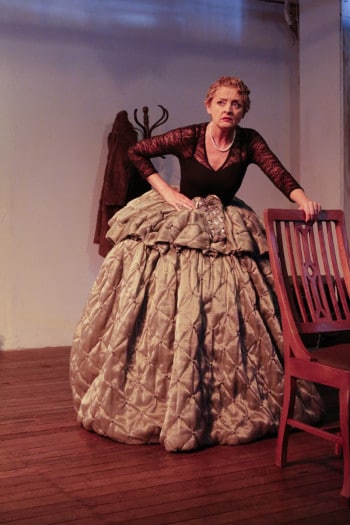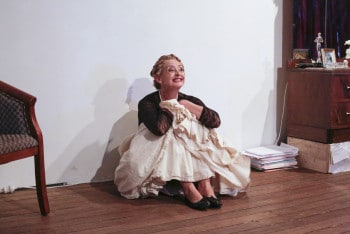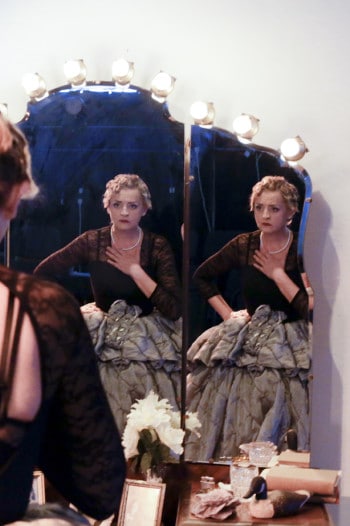Queen Bette, G.bod theatre
“The Queen has no hour for love…”
With a crash of glass Bette takes the stage. She is a volatile force, a strong rush of wind.

Queen Bette is part biographical. Blurring the line between imagined and real, it retells the life of Bette Davis, arguably Hollywood’s most prolific actress and one of the greatest movie stars of all time.
It is also a one-woman show where Jeanette Cronin as Bette Davis delves deep into the actress’ past, beginning with her fledgling start on Broadway until her unrivalled rise in Hollywood.
We witness pivotal moments that came to shape Bette in the public eye as well as bedevilled her private life. Most prominently, we see her notorious legal battle with Warner Brothers, a battle she fought on the grounds of her artistic independence and lost, as well as the period after her mother’s death. Both moments it seems were profound junctures in Bette’s life, times of artistic paralysis and relationship failure. From these nadirs however Bette reappears indomitable and, in the case of her Warner Brothers suit, more successful and prodigious than before.
In devising the script Peter Mountford and Jeanette Cronin pulled verbatim material from the interviews Bette Davis gave over her lifetime. Thus, what emerges from Queen Bette is a sincere portrayal that tries to avoid the pigeon-holing the Hollywood legend has suffered over the decades.
In many respects Bette Davis came to be famed as a temperamental and truculent actress who would wrest dramatic control from directors and writers and terrorise the other actors on set. In Queen Bette the script reflects a characterisation more akin to how the actress saw herself.
Referencing many of the roles Bette Davis played on screen, the script revolves around Bette’s fascination with Queen Elizabeth I (whom she played twice in two separate films) as well as her reverential love for her mother, Ruthie.
In fact the performance itself is bookended by scenes that seemingly take place in Bette’s dressing room during the filming of The Private Lives of Elizabeth and Essex. As the action of the play takes place the set morphs with Bette. From her dressing room it becomes: the filthy flat she, her mother and sister share when they first move to New York; the stage upon which she makes her dancing debut; and the metaphorical battlefield where the three central female figures of this play, Bette, Ruthie and Elizabeth I, converge.
Mountford, who co-founded G.bod theatre and directs the play, first approached Cronin with the idea three years ago. Both are Bette Davis fans and there was clearly a need to recast and reintroduce this seminal figure back into the minds of many young people who have never heard of her. Whatever her personal drawbacks, she was among the first generation of stage actors poached to appear in the “talkies”, as films with sound were known at the time. Her and her contemporaries pioneered the techniques behind modern screen acting and their place in the annals of dramatic art should not be forgotten.

Jeanette Cronin as the one-woman behind this one-woman show brings the audience an honest adaptation of the glittering star. Cronin fleshes out the vulnerability and vitriol, the playfulness and the ferocity that so marked Bette Davis’ personality. It is no easy character to play but Cronin gets it right. Queen Bette is both naïve and articulate, artificial yet deliberate.
Further, Cronin’s voice-work is fantastic. She neatly captures Bette’s Boston-Anglo accent of the time with its rounded and aspirated “h’s” (aitches).
What brings home Cronin’s performance however is the likeness she bears to Bette Davis beyond her physical appearance. Cronin has often played forward-thinking roles and she is no stranger to risk. Indeed, she was in the original play-reading of the controversial play The Boys in 1988, a work she revisited at the Griffin theatre in 2012. Bette Davis was an actress similarly known for her willingness to take on ‘unconventional’ female roles, hard-nosed and unlikeable characters, at a time when such a thing could spell career-suicide. In Bette Davis, Cronin seems to have found a kindred spirit and this gives her characterisation a believability a different actress may have lacked.
In the Old 505 theatre the intimate cabaret style of the performance can be intimidating. One feels almost in exclusive dialogue with the actor onstage. As we near the end and traverse the broken ground of Ruthie’s death, Queen Bette loses her composure and is driven to place her mother’s white satin gloves on an empty front-row seat. Ruthie commanded a seat always be left for her on opening nights. The transmission of emotion is visceral and the proximity compounds it.

Juz McGuire designed the lighting, and its dimming and hued effect tells us we’ve entered moments in which Bette is now playing a previous role. Amidst the monologue however this hued effect leaves one to ponder whether what we’re experiencing is a curated flash-back or the nostalgic inner dialogue of a fairly egocentric old dame. It never becomes clear.
More unclear was the motivation behind some of the sound effects. There was an incongruous thunderstorm effect employed during moments of intensity and it detracted from the soliloquy the play so crucially rests on.
Bette’s blind focus on her career is a dominant theme. She appears as a woman standing on her own, ambitious and driven by a belief in herself as an artist. Her clear-eyed determination is a feature she patently inherits from her no-nonsense mother and that she shares with Queen Elizabeth I.
“It has been my experience,” Bette schools the audience, “that one cannot in any shape or form depend on human relations for lasting reward, it is only work that truly satisfies. I think I’ve known this all my life.”
But there are moments of fragility. She herself admits the costs of her careerism, lamenting that there are “things you drop going up the ladder that you need again being a woman”. Her series of broken marriages are the most obvious victims of her dogged ambition.
Building to her mother’s death, Bette has been entering and exiting varying states of undress. As we approach the finale she stands bared naked – underneath her gnarly exterior is a self-doubting soul. It brings to mind a conflicted scene in The Private Lives of Elizabeth and Essex where the lovelorn and neurotic Elizabeth questions the Earl of Essex’s fidelity. Resonant of that same scene and before the final curtain call, Queen Bette takes up her fur coat, her cigarettes and her self-control with elegant defiance – in the end the Earl goes to the chopping block, she however perseveres.
Bette Davis and the women she embodies are forever.
Queen Bette is being staged by G.bod theatre at Old 505 in Surry Hills, from 25 February to 15 March 2015, presented as part of the Sydney Gay & Lesbian Mardi Gras Festival. Tickets: $33 adult/ $22


